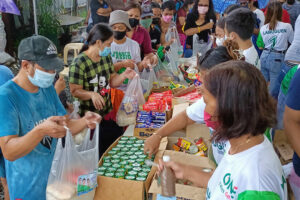No reason to be complacent
From the experiences during the 10 years preceding the coronavirus pandemic and the two years after, there is a very high probability that a 6-7% gross domestic product (GDP) growth year can be maintained annually during the remaining years of the BBM administration, mainly because of what the multilateral lenders called “the structural drivers that are very favorable,” which make them optimistic about the Philippine economy.

(Part 2)
From the experiences during the 10 years preceding the coronavirus pandemic and the two years after, there is a very high probability that a 6-7% gross domestic product (GDP) growth year can be maintained annually during the remaining years of the BBM administration, mainly because of what the multilateral lenders called “the structural drivers that are very favorable,” which make them optimistic about the Philippine economy. As I have described in my own forecasts, over the last thirty years, during which the best and the brightest of our professional economists and financial experts have always been appointed to head key economic departments and agencies in government, there have been enough institutional building and economic policy reforms (the last being the amendment of the Public Services Act, allowing foreigners to own 100% of vital infrastructures and renewable energy) so that private consumption, government spending, and to a lesser extent, private investment, can be the engines of growth of the economy.
As mentioned in the first article of this series, even if a GDP growth of 6-7% may be among the highest in the Indo-Pacific region, there is no reason for us to be complacent because we still have the highest poverty incidence in East Asia. In fact, if we have to bring down this rate to single digits by 2028, we may have to accelerate our GDP growth rate to 6-8% to generate enough resources to combat mass poverty through increased investments in food security, education and health. Here again, we in the private sector cannot just expect the state to do the job alone in eradicating poverty in our country.
To quote from the message of Pope Francis for the 2023 World Day of the Poor, he wrote: “Let us thank the Lord that so many men and women are devoted to caring for the poor and the excluded; they are persons of every age and social status who show understanding and readiness to assist the marginalized and those who suffer. They are not superheroes but ‘next door neighbors’, ordinary people who quietly make themselves poor among the poor. They do more than give alms: they listen, they engage, they try to understand and deal with difficult situations and their causes. They consider not only material but also spiritual needs; and they work for the integral promotion of individuals. The Kingdom of God becomes present and visible in their generous and selfless service; like the seed that falls on good soil, it takes root in their lives and bears rich fruit. Our gratitude to these many volunteers needs to find expression in prayer that their testimony will increasingly prove fruitful.”
Let us try to “deal with difficult situations and their causes.” Why is it so hard to redeem the people in the rural areas from poverty? Let us listen to the experts. Someone who devoted practically all of his professional life to researching on Philippine poverty was the late Dr. Rolando Dy, a leading light in the field of agribusiness. In the last book he wrote before he passed away in October 2023, he said: “Poverty is dominant in the agriculture sector in the Philippines. Rural poverty is 30%. About three-quarters of the poor are rural. Obviously, poverty in the country is an agricultural phenomenon. Poverty in the cities is only 10%.” He then puts the blame on the very small sizes of Philippine farms that militate against increased incomes of the farmers, especially the poorest of the poor, the coconut farmers.
Clearly, one of these “difficult situations” was created by a failed agrarian reform program. As Dr. Dy wrote, “Agrarian reform has not promoted investments. If it did, farm productivity should have increased since 1986. The five-hectare retention limit is too small for private investors. Too small for mechanization. The gross profits barely return the investments if overhead such as manager’s salaries are considered. Small farms can be consolidated but there is a crying need for management and resources. It is time to raise retention limits to a viable size.”
Those who can help in farm consolidation are among those who can respond to Pope Francis in dealing with the difficult situations that have led to mass poverty among the small farmers. What are the various means of attaining more economic sizes of farms in the Philippines? The first is through farmers’ cooperatives that can organize clustering of farms to reach economies of scale. It is true that numerous cooperatives have failed in the Philippines. There are, however, exceptions that can be singled out as role models for success in the organization and operation of cooperatives in the Philippines. There are the Soro-soro Cooperative in Batangas and CARD in Laguna. There is also a cooperative for land consolidation that was organized in Rizal, Palawan by Lionheart Farm. Any effort to consolidate farms for more productive farming is a real contribution to addressing poverty. If Malaysia has reached zero poverty incidence, a major reason was the ability of the government to consolidate hundreds of thousands of hectares through the so-called “nucleus estate” system under which individual small farmers lease their small farms to a large public or private corporation. Large corporate groups like the First Pacific group, the Benguet Corp. and the DMCI group that are investing heavily in corporate farming in sectors such as coconut, palm oil and dairy are to be complimented for applying one of the solutions to rural poverty. As Dr. Dy also reported in his book, a local government unit that has helped in farm consolidation is Piddig, Ilocos Norte, which has succeeded in rice farm consolidation, coffee estates and processing small farm reservoirs and farm tourism, thus reducing poverty incidence significantly. Ilocos Norte has an admirable poverty incidence of only four percent.
In the area of food security, even private citizens can make small contributions to “feeding the hungry.” One of the positive trends during the two years of lockdown made necessary by the COVID-19 pandemic was the appearance of “plantitos” and “plantitas” among numerous middle-income households who had enough resources to go into small-scale gardening of vegetables and other high-value food crops in their backyards or small garden plots. With seeds and technology made available by companies like East West Seed or Harbest, these garden hobbyists started producing cabbage, lettuce, papaya, pepper and other food crops. Part of the produce went to home consumption, but a good number of these “master gardeners” donated their products to low-income households in their respective neighborhoods. These should be continued even after the pandemic is over. In some of the gated subdivisions within the National Capital Region, a committee should be organized to take charge of the collection and distribution of the products of these urban gardens to needy households in nearby depressed areas or institutions like orphanages, feeding clinics in public schools, government hospitals and prisons.
Another initiative that should be replicated in many municipalities is that of the Philippine Food Bank Foundation established in 2014 to collect from food manufacturing enterprises like Alaska, Century Pacific, and Monde Nissin, Arla Milk, Anchor Milk, Del Monte Philippines and URC, as well as restaurants as Starbucks, Krispy Kreme, Dunkin Donuts, Jollibee, Gardenia Bakeries, Coffee Project, and Mary Grace, their soon-to-expire or surplus food and distribute them as quickly as possible to beneficiaries like orphanages, feeding clinics, public schools and prisons. It only takes convincing these sources of donated food items that one’s group has the necessary logistical resources to make the delivery as soon as possible to the beneficiaries, without danger of spoilage, to be able to start a food bank operation. Individuals or small groups who want to start a similar operation in localities outside Metro Manila or Metro Cebu can get in touch with Mr. Danny Navarro at ndanilo91@gmail.com to get advice on what legal and business steps are needed to start such an operation. These food donations are especially crucial if they are made to children in orphanages and schools since the ability of children to learn is often directly correlated to how they are obtaining sufficient nutrients needed to develop their brains. It is scientifically proven that children who were undernourished in their early years of existence have their brains permanently damaged which makes it difficult for them to learn as they grow older. The very low scores Filipino pupils obtain in international achievement tests can be partially attributed to their low learning capacity because of brain damage due to undernourishment or malnutrition. In this regard, provinces like Quezon and Bataan are well known for what is called the 1,000 days program for pregnant mothers and their children. This involves providing sufficient nutrition to pregnant mothers and the children to whom they give birth during the 1,000 days from the womb to the age of two.
(To be continued.)
Bernardo M. Villegas has a Ph.D. in Economics from Harvard, is professor emeritus at the University of Asia and the Pacific, and a visiting professor at the IESE Business School in Barcelona, Spain. He was a member of the 1986 Constitutional Commission.













